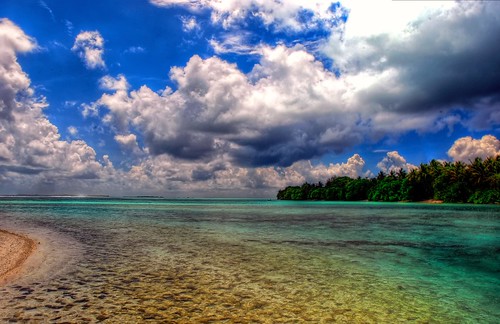
Most of us are all too aware of the limited space on this planet for rubbish, but sometimes, so it seems, garbage might be a solution to limited space rather than a dilemma. In the Maldives, the growing problem of rubbish disposal resulting from the small island nation’s booming tourist industry has forced a creative solution: they built a tropical island out of their trash. It’s called Thilafushi, and it is now home to a number of residences, as well as a cement factory, workshops, warehouses and a boat yard. More than 450 tons of garbage are brought to the still-growing island daily according to an article made available by the World Health organization.
So is it a tropical paradise or a noxious dump? According to a 2009 Guardian article, the increasing but still relatively small amount of electronics, batteries and other potentially hazardous waste that are making their way to Thilafushi could be poisonous to marine life if not properly handled, not to mention a serious health risk for the island’s residents-- most of whom are Bangladeshi migrant workers who sort the trash by hand for recyclables that can be traded for a profit.
They say that necessity is the mother of invention, and this is certainly the case in the Maldives where land space is no laughing matter. The chain of islands will be one of the first areas completely submerged as sea levels rise due to climate change. A similar set of land constraints has pushed Sri Lanka to build an offshore rubbish tip called Pulau Semakau that has rather surprisingly become a destination for ecotourism as it hosts an incredibly biodiverse assortment of rare plant and animal species. Can our garbage save us as our seas swell and space in our landfills runs out? Only time will tell as we watch the marine ecosystems and human populations of these man-made islands. But truly, you have to hand it to the very audacity of trying to save yourself with your own filth.
So is it a tropical paradise or a noxious dump? According to a 2009 Guardian article, the increasing but still relatively small amount of electronics, batteries and other potentially hazardous waste that are making their way to Thilafushi could be poisonous to marine life if not properly handled, not to mention a serious health risk for the island’s residents-- most of whom are Bangladeshi migrant workers who sort the trash by hand for recyclables that can be traded for a profit.
They say that necessity is the mother of invention, and this is certainly the case in the Maldives where land space is no laughing matter. The chain of islands will be one of the first areas completely submerged as sea levels rise due to climate change. A similar set of land constraints has pushed Sri Lanka to build an offshore rubbish tip called Pulau Semakau that has rather surprisingly become a destination for ecotourism as it hosts an incredibly biodiverse assortment of rare plant and animal species. Can our garbage save us as our seas swell and space in our landfills runs out? Only time will tell as we watch the marine ecosystems and human populations of these man-made islands. But truly, you have to hand it to the very audacity of trying to save yourself with your own filth.
Image: notsogoodphotography - flickr





2 comments:
As a San Francisco Bay Area resident, this post reminds me of home. A lot of the cities around the edges of the Bay are actually partially built on “bay fill.” A lot of this fill occurred during the Gold Rush when huge amounts sediment, often contaminated by metals, from hydraulic mining drained into the Bay. Though another source of bay fill was the rubble left over from the 1906 earthquake. They basically dumped in all in the Bay and then built on top of it. Much of this bay fill has destroyed wetlands and contaminated soil and water. Fill is also quite dangerous to be on during an earthquake due to liquefaction. You would think we had learned are lesson and understand the need to protect and preserve our wetlands, but I just saw this article about a potential new Bay side development. http://www.savesfbay.org/siteapps/advocacy/ActionItem.aspx?c=dgKLLSOwEnH&b=484843&aid=9453
An update on the Maldives going green: http://www.enn.com/ecosystems/article/40451
Post a Comment